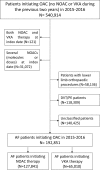Oral anticoagulation therapy use in patients with atrial fibrillation after the introduction of non-vitamin K antagonist oral anticoagulants: findings from the French healthcare databases, 2011-2016
- PMID: 31005934
- PMCID: PMC6500377
- DOI: 10.1136/bmjopen-2018-026645
Oral anticoagulation therapy use in patients with atrial fibrillation after the introduction of non-vitamin K antagonist oral anticoagulants: findings from the French healthcare databases, 2011-2016
Abstract
Objectives: To describe (i) the trend in oral anticoagulant (OAC) use following the introduction of non-vitamin K antagonist oral anticoagulant (NOAC) therapy for stroke prevention in atrial fibrillation (AF) patients and (ii) the current patterns of use of NOAC therapy in new users with AF in France.
Design: (i) Repeated cross-sectional study and (ii) population-based cohort study.
Setting: French national healthcare databases (50 million beneficiaries).
Participants: (i) Patients with identified AF in 2011, 2013 and 2016 and (ii) patients with AF initiating OAC therapy in 2015-2016. PRIMARY AND SECONDARY OUTCOME MEASURES: (i) Trend in OAC therapy use in patients with AF and (ii) patterns of use of NOAC therapy in new users with AF.
Results: Between 2011 and 2016, use of OAC therapy moderately increased (+16%), while use of antiplatelet therapy decreased (-22%) among all patients with identified AF. In 2016, among the 1.1 million AF patients, 66% used OAC therapy and were more likely to be treated by vitamin K antagonist (VKA) than NOAC therapy, including patients at higher risk of stroke (63.5%), while 33% used antiplatelet therapy. Among 192 851 new users of OAC therapy in 2015-2016 with identified AF, NOAC therapy (66.3%) was initiated more frequently than VKA therapy, including in patients at higher risk of stroke (57.8%). Reduced doses were prescribed in 40% of NOAC new users. Several situations of inappropriate use at NOAC initiation were identified, including concomitant use of drugs increasing the risk of bleeding (one in three new users) and potential NOAC underdosing.
Conclusions: OAC therapy use in patients with AF remains suboptimal 4 years after the introduction of NOACs for stroke prevention in France and improvement in appropriate prescribing regarding NOAC initiation is needed. However, NOAC therapy is now the preferred drug class for initiation of OAC therapy in patients with AF, including in patients at higher risk of stroke.
Keywords: France; anticoagulation; apixaban; claims database; dabigatran; rivaroxaban.
© Author(s) (or their employer(s)) 2019. Re-use permitted under CC BY-NC. No commercial re-use. See rights and permissions. Published by BMJ.
Conflict of interest statement
Competing interests: None declared.
Figures



References
MeSH terms
Substances
LinkOut - more resources
Full Text Sources
Medical
